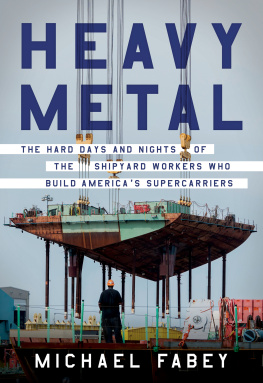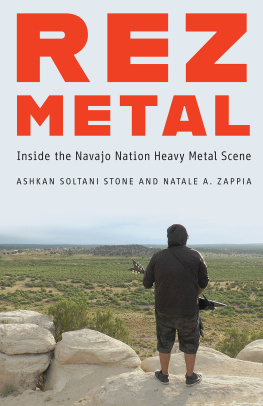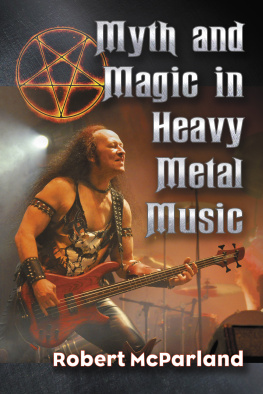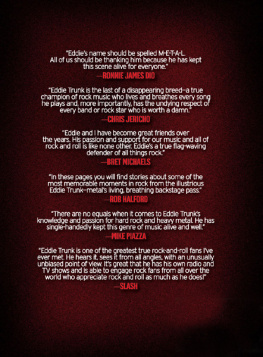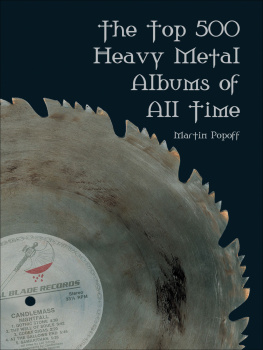Michael Fabey - Heavy Metal
Here you can read online Michael Fabey - Heavy Metal full text of the book (entire story) in english for free. Download pdf and epub, get meaning, cover and reviews about this ebook. year: 2022, publisher: HarperCollins, genre: Home and family. Description of the work, (preface) as well as reviews are available. Best literature library LitArk.com created for fans of good reading and offers a wide selection of genres:
Romance novel
Science fiction
Adventure
Detective
Science
History
Home and family
Prose
Art
Politics
Computer
Non-fiction
Religion
Business
Children
Humor
Choose a favorite category and find really read worthwhile books. Enjoy immersion in the world of imagination, feel the emotions of the characters or learn something new for yourself, make an fascinating discovery.
- Book:Heavy Metal
- Author:
- Publisher:HarperCollins
- Genre:
- Year:2022
- Rating:3 / 5
- Favourites:Add to favourites
- Your mark:
- 60
- 1
- 2
- 3
- 4
- 5
Heavy Metal: summary, description and annotation
We offer to read an annotation, description, summary or preface (depends on what the author of the book "Heavy Metal" wrote himself). If you haven't found the necessary information about the book — write in the comments, we will try to find it.
Heavy Metal — read online for free the complete book (whole text) full work
Below is the text of the book, divided by pages. System saving the place of the last page read, allows you to conveniently read the book "Heavy Metal" online for free, without having to search again every time where you left off. Put a bookmark, and you can go to the page where you finished reading at any time.
Font size:
Interval:
Bookmark:
To my wife, Barb; daughter, Megan; and son, Jason.
Thank you for being the font of my hope, the source of inspiration, and the general reason for getting out of bed every morning.
FALL 2011
The company picnic unfolded unlike any in Virginia before, with thousands of workers, their families, and their cars converging on a waterfront warren of small crisscrossing streets now patrolled and controlled by squads of local police. Nothing small happened at Newport News Shipbuilding and this fall day in 2011 would be no exceptionthe shipyards first Family Day in about two decades to help celebrate its 125th year in existence and just a general acknowledgment of good days now and for the expected future.
The yards siren blared, echoing across the city and beyond, but instead of tens of thousands of hard-hatted steelworkers pushing through the gates, an army of children led the initial charge, sporting smiles and shorts. Overhead, a spritz of drizzle dropped here and there from gray clouds, but no one cared. The rain refresheda late September day like this often heated into a sunbaked scorcher on the Tidewater banks of the James River. Most found the day to be perfect for county fairlike events.
Thats exactly what awaited all those streaming, screaming kids inside those gates where their fathers, mothers, uncles, aunts, brothers, and other kin built the biggest warships of the American fleet. The youngsters lined up for an assortment of rides, a cornucopia of food, and a boatload of games that entertained the spirit and tested the imagination.
Seasoned shipbuilders recalled when the yard celebrated Trade Days inside the gates, and the workers really strutted their stuff, walking family members right up onto the carriers they were building or fixing. Forget about a rollercoaster; the kids had a real ride thensomething no county fair, no other companycould offer at a shindig like this.
Years ago, when my kid was little, they let the kids ride the aircraft elevator, said Big Ed Elliott, who had started working as a full-time shipbuilder as welder about three decades earlier. The little ones would gather on the platform meant to carry the navys planes and make the ride from the hangar to the flight deck and back, the coolest moments imaginable for a youngster.
Those kids didnt give a dang-gone about the rest of the ship, Big Ed remembered. They just wanted to ride the elevator up and down.
Still, workers loved the current Family Day. Being shipbuilders, though, they of course came up with some of their own little touches to improve things. Lee Murphy, another yard worker with more than three decades experience, noticed they were setting up a booth at which kids would try to land paper airplanes on a carrier cutout. He went home and pulled a six-foot-long toy carrier from his attic for the task. Of course, a shipbuilder would have such a thing.
Especially a shipbuilder working for Newport News Shipbuilding, the cradle of all modern carriers. Just a couple weeks before Family Day, the yard had mated the eight-hundred-ton steel stern to the hull of the newest carrier under construction at the shipyard, the Gerald R.Ford, navy ship number CVN 78. Shipbuilders on the waterfront were feeling pretty good about themselves, the ships they were building, and the current course of the US and its navy. But inside the US Navy, analysts remained apprehensive. They anxiously spied the actions of an emerging naval power in the Western Pacific, and they worried about the future of its fleet.
In mid-August 2011, about a month before the Newport News Shipbuilding yard blared its horn to kick off its Family Day celebration, a newly outfitted aircraft carrier blew its own horn half a world away, as it headed out to sea through a thick blanket of fog that enshrouded the port and shipyard of Dalian in Liaoning Province off the northeast coat of China.
The ships eight boilers and four turbines revved up to two hundred thousand horsepower to turn the four shafts, churning up the sea in a milky gray and white that mixed with the fog in a ghostly wake. About a thousand feet long, the ship featured a new engine, radar, guns, and other systems that it would be testing that month on sea trials.
The ship now plowing its way through the Bohai Strait, east of the Yellow Sea, bore little resemblance, operationally, to the empty hull China had bought from the Ukraine decades before.
Called the Varyag (from the Russian word Varyagi, meaning Viking) when the ship was built for the Soviet Union in the 1980s, the incomplete carrier sat and rusted on the Ukraine waterfront after the Soviet collapse. A Chinese company bought the Varyag to keep it from being scrapped. The company said it planned to anchor the ship in Macau as a floating casino, a story few believed. China towed the ship to Dalian, to be finished and outfitted with modern operational equipment and systems.
China said it planned to use the ship mostly for training and researcha story that many naval experts found more believable, given the ships older design, the need for logistical support, and the utter lack of experience in the Peoples Liberation Army Navy, or PLAN, in operating any carriers.
In Newport News, they laughed off the Chinese carrier, which was built to carry about two thousand people and relied on a ski-jump flight-deck designaircraft revved to full power and blasted off a ramp to gain flight attitude, reducing the amount of fuel, bombs, or other weapons they could carry. US Navy carriers built in Virginia carried about three times as many crew members and used powerful catapults to fling planes off the ship, loaded with gas, bombs, and other payloads needed for combat. The way the American shipbuilding pros reckoned it, China was at least two decades behind the US. It would be years before PLAN could deploy this contraption.
Still, the overhauled and updated Varyags sea trials of August 2011 concerned quite a few in the US Navy. And in the US Pacific Command. And in the Pentagon. And in the military commands of just about every Asian nation, including long-time American allies and partners. With these sea trials, China was joining the very exclusive club of nations with operational aircraft carriers. Virginia shipbuilders might see the Chinese carrier as a joke; other naval strategists saw it as a warning. The US was the only country with a permanent carrier presence in the regionwith one shipand here was China testing one of its own while building another from scratch at that very moment, with plans for more.
A central question loomed: What did China plan to do with a carrier force? A Japanese defense study released at the time raised concerns about Chinas unwillingness to tell the world the extent of its military plans.
While Beijing remained officially mum on the subject, Japan, the US, and others could glean what the general thoughts might be among Chinese leadership from the popular and influential 2010 book The China Dream: Great Power Thinking and Strategic Posture in the Post-AmericanEra, written by retired Peoples Liberation Army colonel Liu Mingfu.
A highly respected Chinese military strategist, the former PLA officer wrote, In the 21st century China and the US will square off to become the champion among nations. He argued that China and America are destined for fierce competition and the world is too important to give to the United States. Therefore, he said, China must revive its martial spirit... a kind of spirit that dares to risk its life for the survival of a nation.
As an ideal, China Dream became the policy and mantra of President Xi Jinping, who showed his strong support for the ambitious carrier program.
In its own report assessing Chinas military, released in 2011, the Pentagon predicted, During the next decade China is likely to fulfill its carrier ambitions.
Font size:
Interval:
Bookmark:
Similar books «Heavy Metal»
Look at similar books to Heavy Metal. We have selected literature similar in name and meaning in the hope of providing readers with more options to find new, interesting, not yet read works.
Discussion, reviews of the book Heavy Metal and just readers' own opinions. Leave your comments, write what you think about the work, its meaning or the main characters. Specify what exactly you liked and what you didn't like, and why you think so.

